The Poppy
In November, people in many countries wear poppies to commemorate veterans from numerous conflicts. So today, I thought it may be a good idea to look into why we use the poppy as a symbol of remembrance.
The Poppy
During the First World War, Northern France and Belgium were being torn apart by the war. The land was full of craters and other signs of the conflict. In early spring, 1915, a bright red flower started growing on the battle fields and makeshift graveyards. That flower was the poppy. How was the poppy able to grow there?
The poppy was technically a weed and as we all know, weeds can grow anywhere.
The bright red flowers were one of the sights that inspired Lieutenant Colonel John McCrae to write In Flanders Fields after the Second Battle of Ypres. McCrae tended to the wounded after the battle, a battle where the Germans used chlorine gas for the first time. McCrae's friend, Lieutenant Alexis Helmer, was among the dead.
In Flanders Fields was published later that year.
In Flanders Fields
The fact that the idea of wearing a poppy came from this poem is likely surprising to no one reading this. But, it was not the poem alone that made the poppy a symbol of remembrance. McCrae's poem inspired both Madame Anna Guerin and Moina Michael to campaign for the poppy to be adopted by allied nations as a symbol of remembrance.
Madame Anna Guerin of France founded a charity to help rebuild regions of France after the First World War. She created fabric poppies and sold them to help raise money. She organized veterans, women, and children to make and sell the poppies to help rebuild her country. She brought her campaign to England and in November 1921, the Royal British Legion (a new organization) held its first "Poppy Appeal," where millions of silk poppies were sold, raising over 106,000 pounds. This money helped veterans find housing and employment. The next year, Major George Howson set up a Poppy Factory in Richmond, England where disabled veterans were hired to make fabric and paper poppies.
Madam Guerin later presented the idea of the poppy being a symbol of remembrance to the allies of France, including The Great War Veterans Association (precursor to the Royal Canadian Legion), who adopted the idea on July 6, 1921.
Moina Michael was a professor at the University of Georgia but had taken a leave of absence to volunteer at the New York headquarters of the Young Women's Christian Association (YMCA), which was training and sponsoring overseas workers. Michael read In Flanders Fields and wrote We Shall Keep Faith in response. When the war ended, she returned home and began making and selling red silk poppies. She sold them to raise money for returning soldiers.
Michael went further and campaigned for a poppy (in the colours of the Allied nations' flags) entwined around a victory torch to become a national symbol of remembrance. At first, she did not gain much traction, until in the mid 1920's when she convinced Georgia's branch of the American Legion to adopt the poppy. Then in September 1920, the National American Legion adopted the poppy as its sign of remembrance. Madam Guerin was also invited to the American Legion to talk about the need for an "Inter-Allied Poppy Day."
Why don't we see poppies in the media?
There is a reason the poppy is only used for remembrance. Simply put the Royal Canadian Legion has a trademark on it to ensure it is only used for remembrance and a 1948 Act of Parliament further enshrined it as a symbol of remembrance.
If a person or business wants to use the poppy, they need to contact the Royal Canadian Legion. Their website is pretty clear on when it can/cannot be used, etc.
Pruitt, Sarah. "The WWI origins of the Poppy as a Remembrance Symbol." History. May 21, 2020. https://www.history.com/news/world-war-i-poppy-remembrance-symbol-veterans-day
"The Poppy." Royal Canadian Legion. https://legion.ca/remembrance/the-poppy#:~:text=The%20idea%20for%20the%20Remembrance,of%20fabric%20to%20raise%20funds.


Comments
Post a Comment